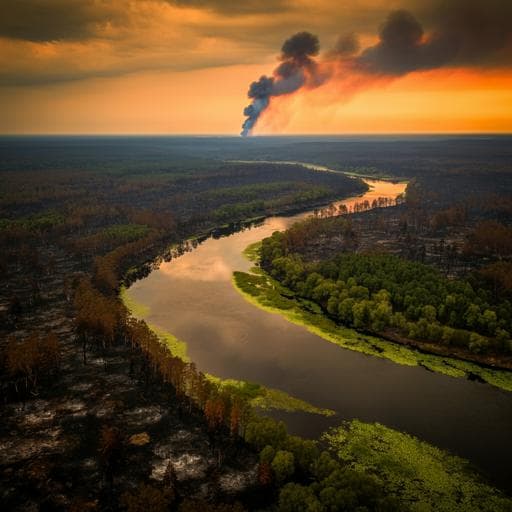
Environmental Studies and Forestry
Longitudinal propagation of aquatic disturbances following the largest wildfire recorded in New Mexico, USA
J. Nichols, E. Joseph, et al.
Explore the intriguing dynamics of wildfire disturbance propagation along fluvial networks, as uncovered by researchers Justin Nichols, Eric Joseph, Asmita Kaphle, Paige Tunby, Lina Rodríguez, Aashish Khandelwal, Justin Reale, Peter Regier, David J. Van Horn, and Ricardo González-Pinzón. This groundbreaking study, based on the historic Hermit's Peak-Calf Canyon Fire in New Mexico, reveals unexpected impacts on surface runoff and water quality that extend far downstream.
~3 min • Beginner • English
Introduction
The study addresses how wildfire disturbances propagate through fluvial networks and affect hydrology and water quality over distance and time. With wildfires increasing in frequency, extent, and severity, they alter watershed characteristics (vegetation cover, soil properties like water repellency, sealing, and aridity) and subsequently increase and modify runoff responses, sometimes producing extreme floods. Post-fire mobilization of burned materials drives water-quality disturbances (sediment, nutrients, ions, metals, dissolved oxygen declines) that can affect downstream systems for years to decades. Despite known local impacts and a few case studies showing effects hundreds of kilometers downstream, the coupling of post-fire rainfall-runoff and downstream propagation of aquatic disturbances remains poorly quantified. In response, the authors deployed a rapid-response monitoring network during the 2022 Hermit’s Peak–Calf Canyon (HPCC) gigafire to quantify: (1) fire impacts on terrestrial vegetation and surface runoff, (2) longitudinal propagation of post-fire runoff events and associated water-quality impacts, and (3) sub-annual impacts on water-quality dynamics and ecosystem processes across connected watersheds.
Literature Review
The authors summarize prior work showing that wildfires increase sediment export proportional to burned area, elevate total ion export, nutrients, and metals, and can episodically depress dissolved oxygen. Many aquatic disturbances subside within about five years, though some persist for decades. Limited prior longitudinal datasets have documented downstream impacts extending hundreds of kilometers, affecting reservoirs and municipal supplies. However, the mechanistic coupling between post-fire rainfall-runoff events and the propagation of water-quality disturbances through both burned and unburned parts of watersheds is not well constrained. Existing fire models predict larger, more frequent fires under climate change and current forest management regimes, increasing the need for spatially resolved longitudinal monitoring and predictive frameworks for disturbance propagation in fluvial networks.
Methodology
Study area and design: The 2022 HPCC wildfire (New Mexico, USA) ignited April 6 and was contained August 21 after burning 1382 km². Monitoring targeted two fluvial networks: Gallinas Creek–Pecos River and Sapello–Mora–Canadian Rivers. Sites included Gallinas Creek (P120, P226, P361, P4136), Pecos River (P5167), Sapello Creek (C129), Mora River (C286), and Canadian River (C3178). Longitudinal sampling spanned from headwaters within the burn scar to downstream river segments up to ~178 km from headwaters. Data were partitioned into pre-connectivity (May to mid-June 2022) and post-connectivity (mid-June to mid-September 2022) corresponding to the onset of Monsoon rains mobilizing burned terrestrial materials.
Hydrology and meteorology: Discharge and stage data at 5–15 min intervals were obtained from USGS gages at or near sites. Where gages were absent (P120, C129, C286), discharge was estimated using lagged relationships, historical gage comparisons, attenuation assumptions, and travel-time estimates derived from water-quality signals. Rainfall data (5-min) were from USGS raingages; air pressure and shortwave radiation were from NASA NLDAS (hourly, 0.125°), and additional meteorological data from MesoWest (10-min).
Data QA/QC: Time series were processed in Aquarius Timeseries with moving average outlier removal (±20% from 2-h window), linear drift corrections between maintenance events, and visual inspection. Some sensors experienced outages or damage (e.g., P120 terminated Aug 28; P361 had a June 20–July 11 gap; P5167 DO damaged after Sept 4 and removed).
Vegetation impacts: Enhanced Vegetation Index (EVI) time series (2007–2022) from MODIS Terra/Aqua V6.1 (16-day composites, 250 m) were masked to burned portions of the Gallinas and Sapello watersheds using StreamStats shapefiles. Pre-fire 15-year means and standard deviations were computed per date and compared with 2022 values before and after fire onset.
Hydrologic modeling: HEC-HMS (v4.10 beta 8) hydrologic models used SCS Curve Number (SCS-CN) for losses, with basin parameters from NLCD 2019 and NRCS SSURGO soils. Models were calibrated pre-fire at USGS gage P226 adjusting SCS-CN, lag time, and peak rate factor. Post-fire parameters were modified using wildfire hydrologic impact factors based on percentages of high and moderate burn severities to adjust SCS-CN and lag. Event-based simulations were run for three isolated storms (07/09, 08/03, 09/10/2022), using observed rainfall and setting baseflow from observed instantaneous discharge. NOAA Atlas 14 rainfall frequencies and USGS StreamStats discharge frequencies informed AEP comparisons.
Water-quality data: Semi-continuous sensors recorded DO, fluorescent DOM (fDOM), pH, specific conductivity (SpCond), turbidity, and temperature. fDOM was corrected for temperature and turbidity using published equations and coefficients; PAR was estimated from shortwave radiation (factor 2.11). Hydraulic geometry relationships were developed to estimate depth and velocity from discharge and cross-sectional data.
Historical vs post-fire discrete comparisons: At P226 (near Las Vegas, NM intake), historical USGS discrete samples (pre-1990) for suspended sediment discharge (SSD), turbidity, and nitrate were compared to 2022 post-fire samples. Turbidity units (JTU vs NTRU) were treated as roughly equivalent. Non-parametric Mann–Whitney U tests assessed differences.
Ecosystem metabolism: Daily gross primary production (GPP) and ecosystem respiration (ER) were estimated using the USGS streamMetabolizer one-station Bayesian model based on oxygen mass balance with gas exchange (K600), stage, temperature, and light forcing. Metabolic fingerprints (kernel density of GPP and ER) were generated to compare regimes across periods and sites.
Multivariate analysis: Principal component analysis (PCA) on standardized daily means (centered, scaled) of DO, fDOM, pH, SpCond, turbidity, GPP, and ER characterized joint variability and separation of pre- vs post-connectivity periods.
Propagation analysis: Wavelet coherence (Morlet, WaveletComp R package) quantified time–frequency localized correlations between upstream–downstream pairs for pH, temperature, DO, SpCond, and turbidity. Periods ≥24 h were removed to isolate sub-daily connectivity attributed to storm/runoff events rather than diel cycles.
Study context: Burn severity distributions were quantified for Gallinas and Sapello subbasins above key sites. The region is predominantly non-urban, and arid-land losing conditions, human withdrawals, reservoirs, and evapotranspiration influence longitudinal discharge attenuation and disturbance transport.
Key Findings
- Vegetation and runoff shifts: EVI dropped sharply after fire ignition and remained below pre-fire averages throughout 2022, indicating severe vegetation loss. Post-fire monsoon rainfall events that were common (<50% AEP, ~≤2-year recurrence) generated much larger runoff responses than expected under pre-fire conditions, with HEC-HMS pre-fire simulations predicting 0.9–4 m³/s peaks versus 20–60 m³/s with post-fire parameters. Observed post-fire peak flows approached 10% AEP (~10-year recurrence), demonstrating a strong shift in watershed response.
- Runoff propagation attenuated downstream: Six distinct post-fire runoff events in Gallinas–Pecos showed consistent downstream attenuation in amplitude and volume. Median direct runoff volume decreased from ~312,000 m³ at P226 to ~47,200 m³ at P5167; station-to-station median volumes were ~53.4% (P226→P361), 54.6% (P361→P4136), and 52.0% (P4136→P5167) of the immediate upstream value, indicating persistent losses along the arid network.
- Historical vs post-fire water quality near burn perimeter (P226): Significant (p < 0.05) increases post-fire in SSD, turbidity, and nitrate. Proportions exceeding the pre-fire medians increased (SSD: 80% vs 52%; turbidity: 90% vs 50%; nitrate: 89% vs 19%). Maxima relative to the pre-fire median increased markedly (SSD: 11,023-fold vs 107-fold pre-fire maxima; turbidity: 120-fold vs 29-fold; nitrate: 23-fold vs 4-fold). Some early post-fire events produced turbidity exceeding historical levels even at much lower discharge.
- Ecosystem processes altered: Diel DO variability decreased post-connectivity, and metabolic fingerprints indicated declines in GPP and ER at three sites (P226, P361, C129), with ER increasing at C286. Reduced GPP was attributed to scouring flows and light limitation from elevated turbidity and sediment transport. Signals persisted for months and at sites far (>160 km) from the burn perimeter.
- Disturbance signal propagation: Wavelet coherence revealed increased sub-daily coherence in pH and other parameters during runoff events in shorter, upstream reaches within the burn scar (e.g., P120–P226), with attenuation in longer downstream reaches (e.g., P226–P361), consistent with dispersion and in-channel processing. Temperature showed the highest average coherence across sites; SpCond and turbidity the lowest; DO and pH intermediate. Detectable propagation extended to the most downstream sites (P5167, C3178).
- Longitudinal extent: Disturbances originating in headwaters (L1 ≈ 0.6 km) propagated at least to the 5th-order Pecos River (P5167) and into Santa Rosa Lake (~180 km). The observed stream+river length impacted (SLLE) approximated the stream length burned (SLBA) in both networks (Gallinas SLBA ≈ 223 km; Sapello SLBA ≈ 197 km), supporting SLLE ≈ SLBA as a practical predictor.
- Moderation by arid-land conditions and reservoirs: Net losing conditions, intermittent segments, infiltration to groundwater, in-channel deposition, reduced withdrawals during contamination, and reservoir trapping (Santa Rosa Lake, Conchas Lake) collectively attenuated downstream propagation. Despite attenuation, local impacts were severe enough to force Las Vegas, NM to halt Gallinas Creek withdrawals near P226 and install additional filtration.
Discussion
Findings demonstrate that a gigafire can transform rainfall–runoff generation such that frequent, moderate rainfall produces infrequent, large runoff events, mobilizing sediments and solutes that propagate along river networks. However, in arid, predominantly losing watersheds with intermittent segments and reservoirs, downstream propagation is strongly attenuated by advection–dispersion, transient storage, infiltration, deposition, and biogeochemical processing. Wavelet coherence confirmed that sub-daily water-quality disturbances generated near the burn scar propagate and then damp with distance and longer reach length. The substantial declines in diel DO amplitude and GPP, with variable ER responses, indicate that scouring flows and turbidity-driven light limitation can impose sustained ecosystem functional impacts far downstream over months, affecting ecosystem services and drinking water security. The observed agreement between impacted stream length and burned stream length (SLLE ≈ SLBA) provides a simple, practical metric for anticipating downstream extent of disturbance in arid networks, with larger stream-order length ratios likely needed to match observed propagation where losing conditions lengthen effective distances between orders. Overall, the results highlight the coupled and context-dependent nature of atmospheric forcing, terrestrial burn severity and recovery, and aquatic transport and processing in determining net post-fire outcomes along fluvial corridors.
Conclusion
This rapid-response, longitudinal monitoring of the HPCC gigafire shows that post-fire runoff responses intensify dramatically even under common rainfall, generating unprecedented sediment and nutrient disturbances that propagate over hundreds of kilometers but are moderated by arid-land hydrologic losses and reservoirs. Persistent alterations in water quality and ecosystem metabolism occurred for months and at sites far from the burn perimeter, directly impacting municipal supplies. The study advances methods for tracking disturbance generation and propagation (HEC-HMS event modeling, semi-continuous water-quality sensing, stream metabolism, PCA, and wavelet coherence) and supports SLLE ≈ SLBA as a practical predictor of downstream impact extent in arid systems. Future work should deploy spatially resolved, longitudinal designs across larger river networks, integrate interdisciplinary measurements to link hydrologic connectivity with biogeochemical processing, better constrain antecedent-condition controls and hysteresis, and extend monitoring across multiple post-fire seasons to capture recovery trajectories and the roles of intermittent segments and reservoirs.
Limitations
- Discharge data were sparse or estimated for some Canadian River tributary sites (C129, C286), introducing uncertainty in hydrograph propagation and attenuation estimates. Sensor outages and storm damage (e.g., P120, P361, P5167 DO) caused temporal gaps.
- Historical pre-fire water-quality comparisons were limited to a single site (P226) and to datasets largely collected before 1990, potentially confounding long-term atmospheric deposition or climatic shifts with fire effects.
- HEC-HMS SCS-CN event-based modeling simplifies infiltration/runoff dynamics, assumes deterministic parameters and boundary conditions, and may bias peak and return-interval estimates.
- Observations cover only the first post-fire rainy season with rainfall events ≤2-year recurrence, so responses to rarer, higher-intensity storms were not observed.
- Net losing and intermittent conditions complicate attribution of downstream signals to specific upstream sources; reservoir operations further decouple longitudinal connectivity.
Related Publications
Explore these studies to deepen your understanding of the subject.







